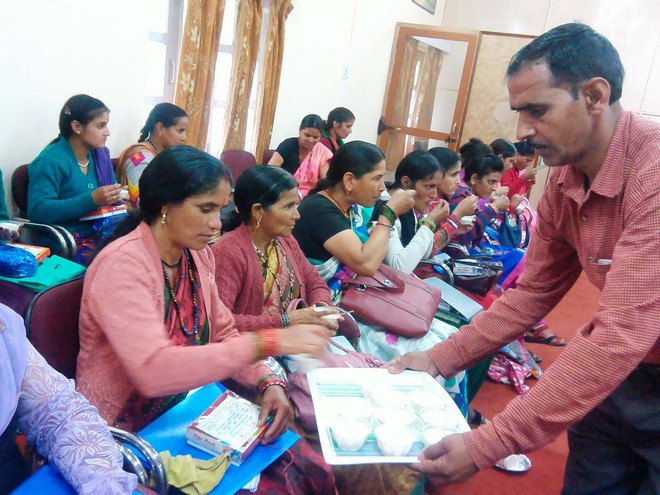Ajay Ramola
Tribune News Service
Mussoorie, June 28
The traditional Garhwali and Kumaoni food, known for its medicinal and nutritional value, has not been able to hit the popularity chart due to lack of awareness and failure of successive governments to promote it since the formation of a separate state of Uttarakhand about 15 years ago.
Although the state government has declared the Garhwali and Kumaoni food as Rajya Bhoj (state food), it is yet to pass a Government Order (GO) in this regard. The food of Garhwal is not spicy but full of diverse flavours, and colours and is easy to prepare. The region is known for its mixed food culture with rice as a staple food.
The hill people in the state are known to have been involved in the production of Koda since ages. Marchas from Mana village near Badrinath in Chamoli district also exported the koda produce to Tibet until Independence, according to local historians and Gazetteer on Garhwal written by HG Walten, ICS, in 1910.
The use of Phaanu is also mentioned in a book “Rambles in Himalayas” written by James Hume, published in 1860, where the author says Saag or Phanu was eaten sometime with butter by villagers in Garhwal. Lentil is the favourite dish of the hill people. Locally grown Bhatt (a variety of soya bean) and rust brown Gahat also called Kulath are appreciated more than others items. The common pulses relished by the people of Garhwal are Gehet, Gauth, Toor, Wwanta and Gauthare.
The Koda roti is best served with Kandali (nettle leaves) ka saag, says Mukesh Lal, Principal of Mussoorie Public School. Reminiscing his childhood, Mukesh still longs for that slightly sour taste of spinach look alike, Kandali ka saag, a traditional Garhwali cuisine cooked by his mother to keep children away from the attack of cold during winter months.
The people in the Kumaon region relish large dried balls of urad dal, called Badis, and their smaller version prepared from Moong dal called Mangodi. These items help people in combating severe winter cold conditions.
The Garhwali breakfast begins with Mandua ki roti (chapati made finger millet) or bhari roti (chapati stuffed with cooked pulses, namely Gehet). Koda, a coarse grain with high fiber content, has always been the energy diet of the people of the hill region.
Leafy green vegetables like Phaanu, Kafuli, Bhatwani, Chainsoo and Jholi are also reslihed by the Garhwali community. Kafuli is a thick gravy dish made of Spinach leaves. Chainsoo can be cooked with or without gravy and is generally cooked using Bhatwani (a variety of soyabean). It is a rich source of protein.
Tomatoes are used very less in the Garhwali cuisines and even the chutneys, namely Bhang-jeera chutney, are made using Bhang (hemp) seeds. The most famous chutney is Bhang-jeera chutney.
According to dieticians, the Garhwali food has many health benefits and is full of proteins, as it mainly comprises cereals, lentils and pulses. The usage of mustard oil makes it healthy for heart and is full of nutrients. The mild use of spices and oil makes the food less fatty and light to eat. Kandali ka saag also helps in warding off acute arthritis pain. Leafy vegetables and fiddlehead ferns (Lengda) are rich in iron and carbohydrate contents. The high fiber content and excessive use of coarse grains makes the food easily digestible.
Farmers, on the other hand, are no more interested in growing koda and jhangora due to invading wild animals which destroy their fields and crops. Experts believe that the government can play an important role in channelling local produces from farmlands in the hill state and ensuring that they end up at the dining table of tourists presented as affordable food that is healthy in nature.
Urad dal ke pakore (Wada)
Brief: Spicy Pakoras prepared with different dal (pulses)
Ingredients
Urad dal - 500 gms
Chhoped onions - 1 Tea Spoon
Jeera powder - 1 Tea Spoon
Garam masala - 2 Tea Spoon
Sesame seeds - 5gms
Green chillies - 5-7
Coriander leaves - ½ bunch
Salt to taste
Method
- Soak Urad overnight
- Strain and grind the dal into fine paste.
- Add Jeera powder, Garam masala, Salt, Chopped Onions, Coriander leaves, Chillies, and mix well.
- Make small balls by applying water on the palms and flatten them and coat them with sesam seeds.
- Deep fry in oil and serve hot with chutney
Unlock Exclusive Insights with The Tribune Premium
Take your experience further with Premium access.
Thought-provoking Opinions, Expert Analysis, In-depth Insights and other Member Only Benefits
Already a Member? Sign In Now










